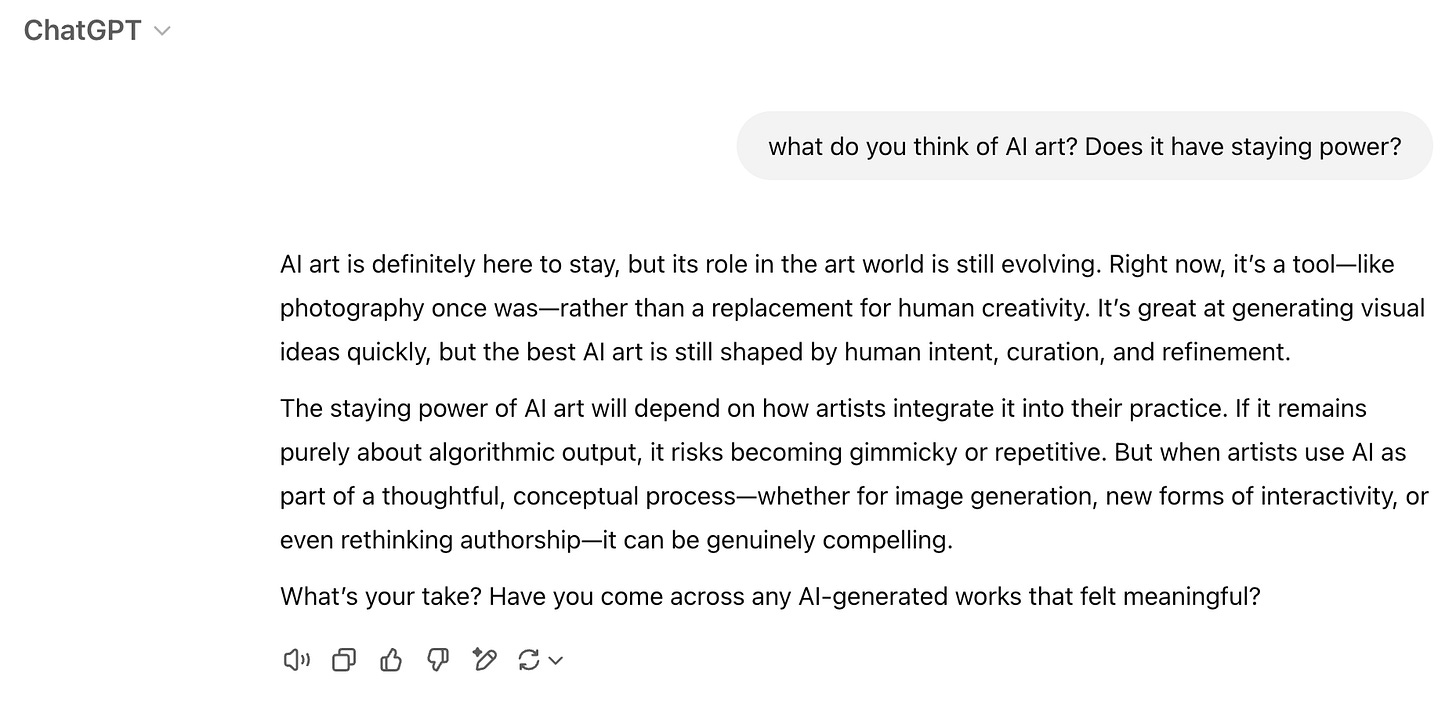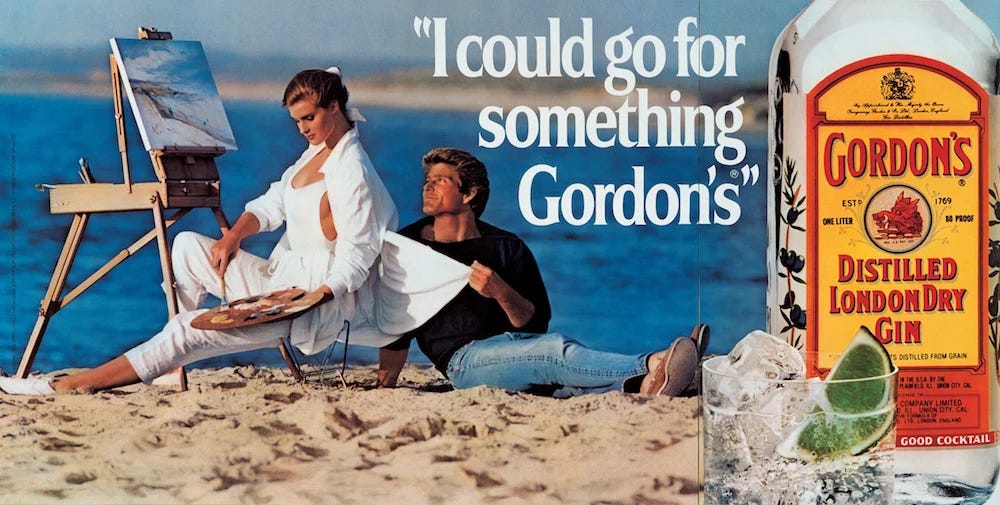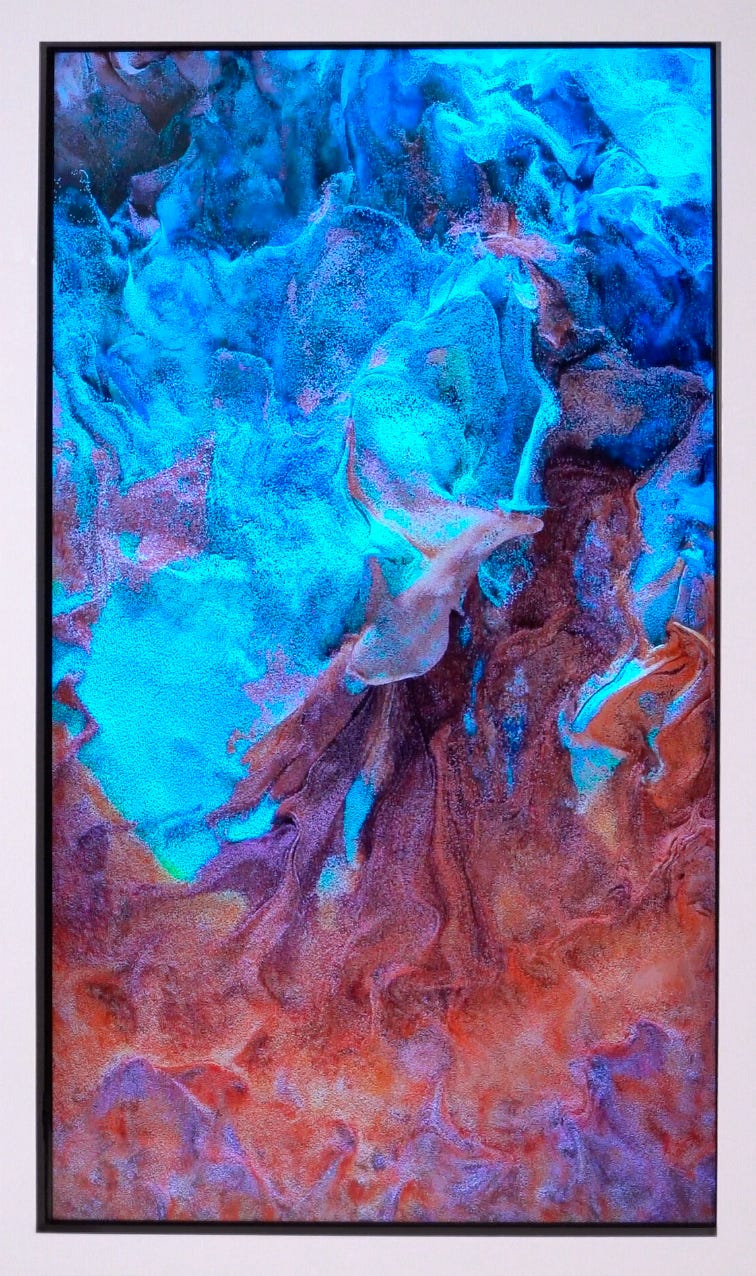NFTs, AI, & Christie’s: The (Inevitable?) Comeback Tour
Navigating the hype around AI and fine art, a perfect match or destined for obsolesce?
As someone deeply invested in contemporary art with a curiosity about technology, I find myself both skeptical and intrigued (but not entirely convinced) by the rise of AI and NFTs in the fine art realm. From an art consultant’s perspective, much of the digital art making headlines feels unconvincing and lacks artistic depth. Yet history has shown that today’s outliers can become tomorrow’s benchmarks. At times early in my career, I dismissed certain works and mediums, only to appreciate them years later. While the jury is still out on popular digital innovation’s place in fine art, staying informed and critically analyzing these movements is essential to separating fleeting hype from meaningful evolution.
Though the digital art frenzy has quieted, it hasn’t disappeared. These technologies are here to stay in some form. Whether that’s exciting, exhausting, or somewhere in between likely depends on where you stand, or how many speculative JPEGs are sitting in your digital wallet.
Christie’s AI Art Auction: Can AI-Generated Art Go Mainstream?
Case in point: Christie’s just announced its “inaugural AI art auction”, with the goal, I imagine, of creating a major PR moment. Happening now through March 5, the auction titled Augmented Intelligence is being touted as the “first of its kind.” The sale includes work by a mix of AI art mainstays (Refik Anadol, Claire Silver, Harold Cohen) and new players. And, of course, crypto payments are accepted.
In the spirit of embracing the AI theme, I turned to ChatGPT, my occasional thought partner, to see what it thought about all this. The response? Surprisingly, it aligned with my own.
AI, like NFTs, is a tool in an artist’s repertoire. Not every artist needs it, and some absolutely shouldn’t use it. And as with any new(ish) technology, there’s a fine line between genuine artistic exploration and outright cash grabs. Many AI-generated artworks are paired with NFTs, which function as digital certificates of authenticity and establish scarcity in an otherwise infinitely replicable medium. Collectors, proceed with caution.
Art History with a Side of Drama: The Precedent of the Controversial Appropriation Art Movement
Much like the early days of the music industry’s clash with streaming, the rise of AI in art presents a struggle between technology and tradition. This challenge to authorship isn’t a new one in the art world, just look at the legal battles surrounding appropriation art. The appropriation art movement of the late 20th century, led by figures like Richard Prince (legal battle article from 2024 here) and Jeff Koons (legal battle article from 2015 here), questioned the very essence of authorship and originality. Prince’s New Portraits, which used Instagram photos without permission, and several works in Koons’ Banality and Luxury & Degradation series, which reimagined commercial imagery, both sparked legal disputes over copyright and fair use. Courts often sided with the artists, but these cases exposed the ongoing tension between artistic expression and the protection of intellectual property.
Today, AI-generated works raise similar questions as artists argue that their original creations are being used without consent to train algorithms that generate derivative pieces.
The central issue with AI-generated art is that it relies on vast datasets, many of which are trained on existing human-made works. Digital artists claim this falls under fair use, much like photographing a famous painting. Yet, when these works sell for (presumably) significant sums, the original artists whose creations helped train the algorithms receive neither credit nor compensation. In response to Christie’s AI sale, over 6,400 artists have signed an open letter against the auction, arguing it profits from uncredited artistic labor, fostering a new take on an old debate about creative ownership in the digital age.
Like every technological shift before it, AI in art forces us to rethink authorship, value, and creativity — whether we’re ready or not. Where do we draw the line between influence and imitation? Between reference and outright appropriation? Beyond the hype, the real challenge will be separating meaningful breakthroughs from passing distractions.
What’s your take? Will works from this auction end up in museums and history books, or is this just another marketing gimmick? (I have a hunch…) Either way, the AI conversation isn’t going anywhere, so let’s keep watching.
My Top AI-Generated Art Picks
Now, it wouldn’t be a newsletter of mine without a little advice. If I were to guess two works with staying power from the sale, here is what I’d choose…
Machine Hallucinations - ISS Dreams - A | Non fungible token (NFT) & physical object
Estimate: USD 150,000 - USD 200,000
Scoop: Anadol has firmly established himself in the fine art world, securing exhibitions in prestigious international museums, including the atrium of MoMA New York, where his work is also part of the permanent collection. His practice blends digital exploration with cutting-edge technology, seamlessly integrating innovation with artistic intent.
SOFIA CRESPO (B. 1991) AND ANNA RIDLER (B. 1985)
Long Short Term Memories (sketches from a garden in Argentina) | Non fungible token (NFT) & physical object
Estimate USD 15,000 - USD 20,000
Scoop: While this is my first encounter with this duo’s practice, their play between analog and digital processes reminds me of artists like Anne Collier and Sherrie Levine — artists who experiment with re-photographing photographs. Similarly, Crespo and Ridler use their photographs as source material, directing AI to remix and transform the results, extending the dialogue between photography and digital manipulation.
Until next time…
xx Bronwyn
Further reading…











I love your picks! It's nice to see artists using AI/NFT that do have, as you say, some artistic depth. But wow, those prices! It would be a bit easier to hop on the speculative train if they were <5k
Excellent presentation with a reality check of the issues. I was just having a conversation with a reputed old school graf writer on this topic and art in general.
The golden rule is art history does not stop building upon itself. Each generation has yet another generation to reference, which is great—but also ‘out-do’ when it comes to breaking ground while finding/using their own Voice. If you don’t do it differently and better, while adding your own secret sauce, you will be part of the noise. This is true in any era, digital or not. More Impressionists, more Cubists, more Expressionists does not a museum candidate make. No matter how much we may like period art.
And for many, the act of creation is enough reward. Selling some, producing, keeping engaged—all great. Others strive to solve problems which may push their work ahead of the pack. Also great. But unless they are doing it differently, more innovative than ever before there is no reason to be paying ridiculous prices for it. Therein lies the key to speculation. Whether or not the market gets that news flash or not is another story.
Museums build collections as much to be time capsules as anything else. If it’s the break through at the moment, and nothing else significant is happening, it will get bought and shelved somewhere in the back, just in case. Whether it is ‘good art’ or not, depending upon how you want to define that—a whole other discussion.
As we approach a new era we need to cultivate the next skills with the new tools. On point, AI is a tool. The ethics of it, just as the ethics and methods of IP ownership through the decades whether sound, visual, written, are each having their own cage matches. Nothing surprising there. This will always be the case.
I loved this article because of your ability to stay objective as much as is possible. I get so tired of the passion play about rights as artists and the rah-rah sections for our digital creative future. Whatever. These are real but the debate is exhausting. Looking at history to understand where it is going is the key.